
version française

download the tale of the shipwrecked sailor below
Of course, hieroglyphs are still the main symbol of ancient Egypt...
They are pretty and legible (it does not mean that their deciphering is easy). They are sometimes true works of art whose technique was known early, even in very old monuments, before 2 500 years BC.




However, it was long an expensive to trace them. Those signs were written for eternity, on
resistant supports to mark solemn events on monuments or artefacts, such as temples, royal buildings or funerary steles.
For that, they were not suitable for everyday life.
Nowdays, one can easily draw hieroglyphs,
without mallet and chisel, with software like JSeh for example.
Here is an example
whitch shows the beauty of the texts using hieroglyphs :
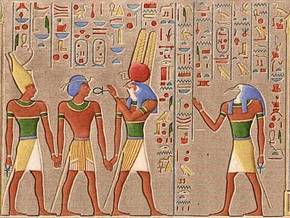
From "description de l'Egypte"
...but egyptians had fortunately an other writing system.
just imagine writing a shopping list needing 3 months of work and 50 kg in weight! early on, other signs
have emerged, able to be quickly drawn with ink on any support. It is a cursive writing, called hieratic.
Unlike hieroglyphs which can be written from left to right and vice versa (sometimes both in a same text), hieratic signs
are always written from right to left, such as arabic writing for example. Signs can also be written in columns, but always
from right to left.
Like as all handwritten scriptures, the result strongly depends of scribe's hand.
The Ebers papyrus below show a nice and neat graph, but often, it is not the case.

extrait du papyrus Ebers, 18ème dynastie
There is a strong link with the hieroglyphs, because cursive signs are a simplification of hieroglyphs. This has been demonstrated
by Champollion, 2 centuries ago. Nevertheless, it is often impossible to identify a hieroglyph from a hieratic sign.
The illustration below shows how the cursive sign of the owl is different from the corresponding hieroglyph. 2nd and 3rd signs are equivalent
to the hieroglyph owl :



Other example with the boat :



After that, we can see that it is difficult to imagin deciphering a hieratic text from a comparition with hieroglyphs.
In fact, we must use correlation tables, which give connections between a hieroglyph and a hieratic sign. Such a work exist, since the begining
of the 20th century.
How to transcribe a hieratic text into hieroglyphs ?
From the example of Ebers papyrus, you want to translate, we first have to transcribe signs into hieroglyphs, easier to handle (todays). Of course, it's possible to directly translate without the transcript, but it is much more difficult. Here is the result of this first step :



Although some signs show a likeness with the hieroglyph which they are derived, it's not conspicuous for most of them.
We can memorize some signs, but they are numerous, and every scribe has his own style. So, we cannot avoid
to refer to correlation tables.
These tables are invaluable. They are due to Georg Möller, a german linguist who published his work in the
early 20th century under the title Hieratische Paläographie.
This work is the reference today, even though his organisation is outdated. The edition is sold out for a long time, but you
can download it for free.
Here is an example of the use of these tables :
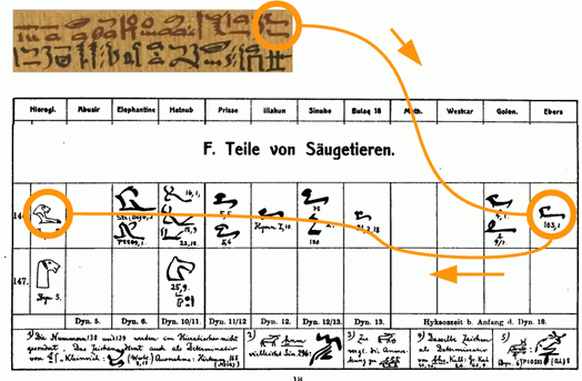
The research in the tables allows you to find the hieroglyph for the first sign of the papyrus. This hieroglyph, such as others, is codified in an international nomenclature developed by Alan Gardiner in the middle of the 20th century (later than Möller's work). The serious problem is that this nomenclature, which is essential for the continuation of the operations of translation differs significantly from the classification of signs used by Möller a few decades before. However, all the modern tools use the Gardiner's classification!
When the transcript is made, we can translate
Hieroglyphs, at least those placed at the begining of words, correspond to a pronunciation. It is this pronunciation which allows to look up in a dictionary. The identification of the sound, in lists designed for this purpose (for example at the end of dictionaries) requires knowledge of the Gardiner's code for this sign. In the example, the first sign represents the front part of a lion, coded F4. The pronunciation of the hieroglyph F4 lets you know where to look in a dictionary. In this case, the pronunciation of the hieroglyph F4 and the identification of the sign below allows you to find the word beginning.
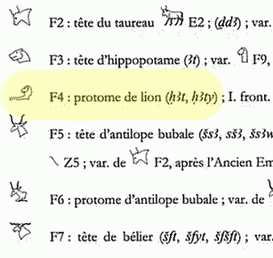

The first lign (in red) can result in : Beginning of the formula to apply a remedy on any part of the body of a man.
Work from the G. Möller's document needs several successive researchs, which is long and inconvenient. The consolidation
of essential informations in the same document would simplify the translation operation. It is what allows the updating of Möller's
work realized, and which can be downloaded from this page.
The updating of Möller's tables
The example below shows why the updated tables are useful :
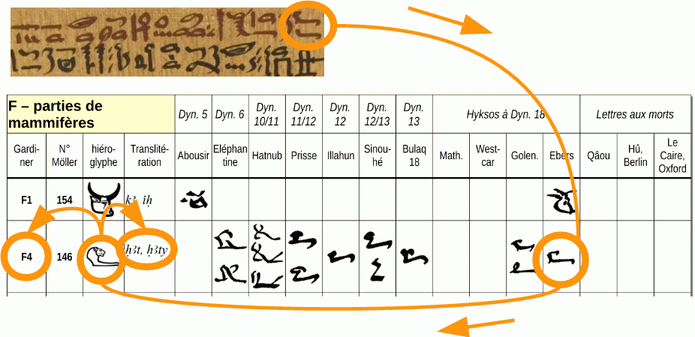
The information is more complete and gives directions to directly look up in a dictionary. More, signs are classified
according to the order of Gardiner which is the current standard. The translation process is more fluid. Finaly, the writing styles
were supplemented by 5 additional categories (3 last columns of the tables). In the example, these columns have no signs.
Two volumes are now available. The first one covers the volume 1 of Möller's work and corresponds to the period from the origins to the 18th dynasty.
The second one has just been written by a team and corresponds to the the period from the 18th dynasty (Thutmosis III) to the 21st dynasty .
They are downloadable below.
These documents needed a lot of work so it is a pleasure to share them.
Westcar Papyrus reconstitution in cursive script
The Westcar Papyrus is a text written in cursive script, preserved in the Berlin museum under the reference 3033. It is a
collection of tales that dates from the end of the middle empire, about 1500 years BC (it may have been composed earlier).
In fact, the tales are a pretext to legitimize the foundation of the fifth dynasty by the gods, which dates back about 2500 years
BC. One can thus make a double reading of these tales: recreational or political. Anyway, the papyrus has lost his first and last part.
What remains is divided into 12 sheets, variously preserved. Some pages are incomplete or partially readable. That's why researchers
(Blackman, Parkinson, Lepper, ... and Laura Parys very recently) have tried to reconstruct some missing words or phrases. Sometimes, the
restitution of these deficiencies are certain ; in other cases, these are solid but not certain assumptions.
A text thus supplemented
by the refunds of Blackman is available in hieroglyphics
for example, or in a more complete version, in the book of Laura Parys published by Safran. But, the cursive version was not available.
I just made it :
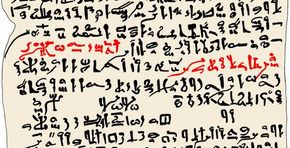
The purpose of this work is to enable people interested, to get a translation of the text from a medium in hieratic writing as
complete as possible. The document is available for download below. The second edition, dated December 2018, shows the
difference between the readable text written in black and red, and the restitutions of the gaps, written in gray and light red.
Le tale of the shipwrecked sailor
The tale of the shipwrecked sailor is a classic of Egyptian literature. It has several advantages: the manuscript is complete
and in very good condition, the language is clear and elegant, the story is pleasant.
Since it was exhumed from the reserves of the Saint Petersburg museum by Golenischeff in 1881, it has been translated many times.
The translation offered for download probably brings little to those who predated it, but it is presented in a different way:
- the first part is devoted to a cleaned reproduction of the papyrus and whose "titles" are colored in red
- the second part is a hieroglyphic transcription accompanied by a transliteration
- finally, the text is illustrated and translated.

The size of the characters is intended for a reproduction in A5 format, but nothing prevents to choose another format print.
Send a mail
Here are some downloads for free
- The tale of the shipwrecked sailor (18 Mo) New - Westcar Papyrus rewrited in hieratic signs, second edition (21 Mo) - actualisation du tome 1 de Möller 2021/01/09 (16Mo) - actualisation du tome 2 de Möller (16Mo) - poster 50x70 : hieroglyphs with their code and their pronunciation (2,5 Mo) - set of table mats A3 : hieroglyphs with their code and their pronunciation (1,3 Mo)- list of signs A4 : hieroglyphs with their code and their pronunciation (16,6 Mo) - Poster 50x70 with hiéroglyphs, hieratic, translitteration and code (5 Mo) New - Hieratic signs in vector format (to be continued...) New
- color hieroglyphs on the top of the page are available at :
http://www.qsl.net/5/5b4az/ (Miscellaneous Software, Egyptian Hieroglyphs)